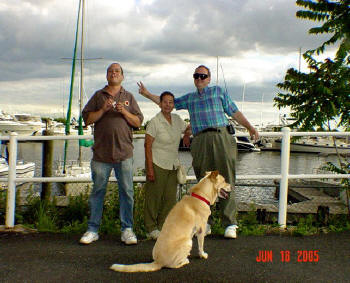SERVICE ANIMALS
General
* If you have a service animal, you are encouraged to inform the TSO that the animal accompanying you is a service animal and not a pet. This will provide you with an opportunity to move to the front of the screening line since the TSO may need to spend more time with you.
* It is recommended that persons using an animal for assistance carry appropriate identification. Identification may include: cards or documentation, presence of a harness or markings on the harness, or other credible assurance of the passenger using the animal for their disability.
* At no time during the screening process will you be required to be separated from your service animal.
* TSOs have been trained not to communicate, distract, interact, play, feed, or pet service animals.
* The TSO should ask permission before touching your service animal or its belongings.
* You must assist with the inspection process by controlling the service animal while the TSO conducts the search. You are required to maintain control of the animal in a manner that ensures the animal cannot harm the TSO.
* If you need to leave the sterile area to relieve your animal, you must undergo the full screening process again. Inform the TSO upon your return to the security checkpoint and she/him will move you to the front of the screening line to expedite the screening process.
SERVICE DOGS
* Advise the TSO how you and your dog can best achieve screening when going through the metal detector as a team (i.e., whether walking together or with the service animal walking in front of or behind you).
* If the WTMD alarms in the situation where you and the animal have walked together, both you and the dog must undergo additional screening.
* If the WTMD alarms on either you or the dog individually (because you walked through separately), additional screening must be conducted on whoever alarmed the WTMD.
* If the dog alarms the WTMD, the TSO will ask the PWD’s permission and assistance before they touch the dog and its belongings. The TSO will then perform a hand inspection of the dog and its belongings (collar, harness, leash, backpack, vest, etc.) The belongings will not be removed from the dog at any time.
MONKEY HELPERS
* When a monkey is being transported in a carrier, the monkey must be removed from the carrier by the handler prior to screening,
* The monkey must be controlled by the handler throughout the screening process.
* The monkey handler should carry the monkey through the WTMD while the monkey remains on a leash.
* When the handler and monkey go through the WTMD and the WTMD alarms, both the handler and the monkey must undergo additional screening.
* Since monkeys may likely draw attention, the handler will be escorted to the physical inspection area where a table is available for the monkey to sit on. Only the handler will touch or interact with the monkey.
* TSOs have been trained to not touch the monkey during the screening process.
* TSOs will conduct a visual inspection on the monkey and will coach the handler on how to hold the monkey during the visual inspection.
* The inspection process may require that the handler take off the monkey’s diaper as part of the visual inspection.






